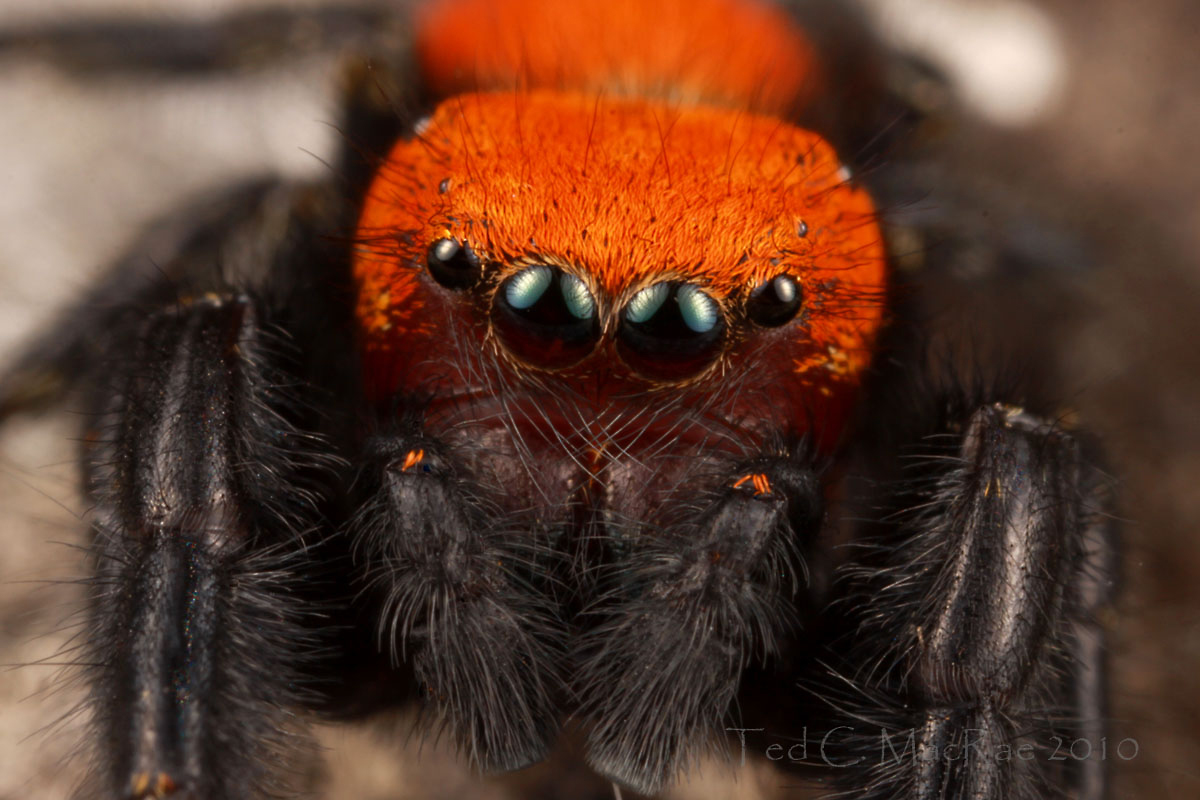Last month I made the fifth and final trip to extreme northwestern Oklahoma as part of a trapping study conducted at several locations throughout the area. Recall the main part of the study involved “jug traps” baited with pure ethanol (EtOH), sweet red wine (SRW), or a 50:50 blend of both (SRW/EtOH) to evaluate their efficacy in capturing longhorned beetles (family Cerambycidae). The traps were set in mid-May with the help of my good friend and longtime collecting buddy Rich Thoma (see First insect collecting trip of the season) and checked at ~5-week intervals throughout the season—first in mid-June at the beginning of a 3-week long collecting trip to the southwestern U.S. with another good friend and longtime collecting buddy, Mike Arduser (see 2023 Southwestern U.S. Collecting Trip iReport), then again in late July (see July “jug trap” run) and late August (see August “jug trap” run), and, finally, this last trip in early/mid-October. The July and August trips were solo, but Rich joined me again for this last trip, which concludes two years of data collection for the study (last year traps were placed across extreme southern Missouri). I plan to begin preparing a manuscript this coming winter to analyze and discuss the findings. I hope you have enjoyed “tagging along” with me on these trips as much as I have enjoyed doing them!
Day 1 — 10 Oct 2023
Alabaster Caverns State Park
Woodward County, Oklahoma
We got here right around 5:30, which left us only with a couple hours of daylight to get the traps taken down. The jug traps were choked full of Euphoria sepulchralis with some Cotinus nitidus—especially the SRW/EtOH trap, but I did see at least one Eburia sp. so hopefully there will be other longhorns as well. I bagged the trap contents from each of the traps for sorting and counting later (the SRW/EtOH trap was so full that my 1-qt bags weren’t big enough and I had to borrow a 1-G bag from Rich). After retrieving the traps we went back up on top to check the white bottle trap and look for beetles on flowers in the shortgrass prairie above the canyon. The bottle trap had been pulled by an animal, so nothing in it☹️, and the only beetles I saw were Chauliognathus longifolia and a variety of meloids on flowers of Guterrezia sarothrae.


Before long it started getting dark, so we headed down to the campground to set up camp, have a beer (or two), and cook some dinner (ballpark brats!).
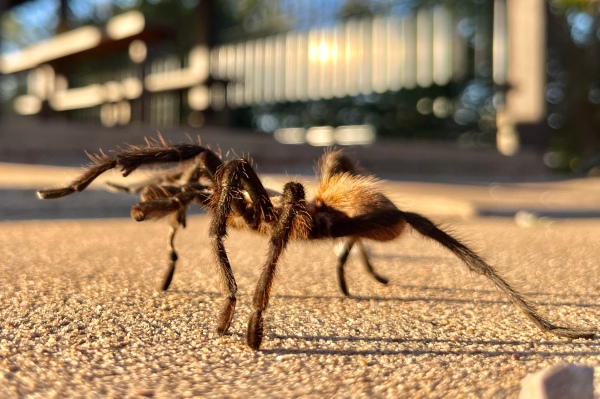
After setting up camp we got started on the fire by collected kindling and small branches, one of which was a dead branch I yanked off a small dead Celtis occidentalis. I could tell as I was pulling it off that it had been well infested by wood boring beetles, and as I broke apart the larger portion of the branch (~1” día.) I found a couple of unemerged Euderces pini adults inside their pupal chambers. After dinner we walked the road back up out of the canyon—immediately starting out I found a Tetracha carolina zigzagging crazily on the road, and up on top of the canyon I found two different species of tenebrionid beetles lumbering slowly on the ground in the shortgrass prairie.

Back at the campsite we found a nice Scolopendron polymorpha centipede—Rich collected it very carefully to avoid getting bitten! It was crazy windy up on top but very calm down in the canyon, and temperatures were Goldilocks for sleeping!

Day 2 — 11 Oct 2023
Sleeping temps were again super nice, and after breakfast and breaking camp we retrieved the Lindgren funnel trap. Like the jug traps yesterday, it was inundated with Euphoria sepulchralis, but since I’m not taking data from this trap we sorted through and discarded them all , finding 5 Neoclytus mucronatus, 2 Elateridae, and 1 Sandalus sp.

We went back up to the shortgrass prairie before leaving the park to check the snakeweed and camphorweed flowers again, hoping that Crossidius longhorned beetles and Acmaeodera jewel beetles might be active. I also wanted to see if I could find another of a meloid that escaped my attempts to photograph it yesterday. There was more activity on the flowers, but nothing of interest until I went to the next shelf down and found the meloid (Epicauta stuarti) on flowers of Gutierrezia sarothrae. I wasn’t able to photograph it on the flowers, but I did get a “finger-photo”. I’m glad I was able to find and photograph it, because it turned out to be a new eastern record for the species on iNaturalist, which contains relatively few records for what must be a rather uncommon species.

Nearby I encountered a large, impressive Say’s grasshopper (Spharagemon equale), which I collected thinking Rich would really want it (he did!). Still, I hadn’t seen any Crossidius or Acmaeodera until I went back on top, and on the last clump of G. sarothrae available to check I found one C. pulchellus still embedded down inside the flowers and not yet active. I wonder how many others I missed!

Gloss Mountain State Park
Major County, Oklahoma
The drive from Alabaster Caverns to Gloss Mountain takes about an hour, so we arrived right at noon. After a bit of lunch, we started out on top of the mesa to check the jug traps. As at Alabaster caverns, they were overwhelmed with Euphoria sepulchralis and lower numbers of Cotinus nitidus, but I did see a few elaphidiine longhorned beetles and elaterid click beetles. Unfortunately the third jug trap (EtOH-only) was broken and with no retrievable trap contents. Trap contents from jug traps A (SRW) and B (SRW/EtOH) were bagged for counting at a later date. The white bottle trap also had perhaps more than 100 E. sepulchralis (no vouchers) plus 1 Meloidae (and 1 wasp, 1 bee for Mike). There was lots of different flowers in bloom, giving me hope that insects, especially beetles, might be found on them. Some, like Polanisia dodecandra (redwhisker clammyweed) are not normally associated with beetles (at least not to my knowledge), but others such as camphorweed (Heterotheca subaxillaris), snakeweed (Gutierrezia sarothrae), and any number of Solidago spp. (goldenrods) are.


I focused on camphorweed and snakeweed, by far the most abundant blooms out but also flowers in which I’ve found longhorned beetles and jewel beetles previously. No beetles were seen on them for some time, but eventually I found a single individual of Crossidius discoideus on the former and two C. pulchellus on the latter.

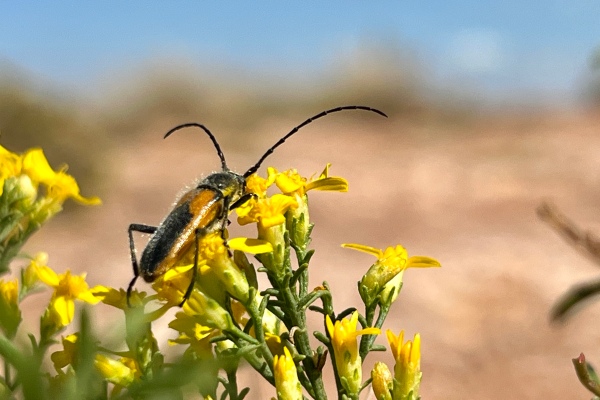
Shortly afterwards I finally found Acmaeodera macra, first on the flower of H. subaxillaris and then on the flower of G. sarothrae—both times just a single individual.

Down below I continued checking the snakeweed and camphorweed flowers—to no avail, so I proceeded with checking the traps. The first jug trap (SRW) was broken and no trap contents recovered, but the SRW/EtOH trap was intact and overwhelmed by E. sepulchralis with many fewer C. nitidus and even a couple of Plinthocoelium suaveolens—trap contents were bagged for counting at a later date. The white bottle trap had about a dozen E. sepulchralis (no vouchers) and 1 meloid (plus 4 bees for Mike). I was disappointed that neither of the bottle traps caught any A. macra, which I’d just collected on top of the mesa and, thus, know they are here and active—perhaps their numbers are too low to effectively trap, or perhaps the beetles would prefer a yellow-colored trap to a white-colored one.

Beaver Dunes Park
Beaver County, Oklahoma
Once again there was only about an hour of daylight to work with by the time we got here, so I got to work quickly. I was hoping I would be outside the western limit of the range of Euphoria sepulchralis, which had overwhelmed the traps at Alabaster Caverns and Gloss Mountain State Parks, but such was not the case. Nevertheless, the first trap I checked (SRW) I saw a huge male Tragidion coquus—one of my highest priority target species—sitting on top of the beetles filling the jug! I grabbed it and secured it separately, then bagged the rest of the trap contents. There were other Cerambycidae in the trap, though I did not detect more T. coquus, and the same was also true in the SRW/EtOH and EtOH traps. The white bottle trap had 1 Acmaeodera sp. (prob. mixta) and 4 E. sepulchralis (plus 4 bees for Mike), and after retrieving all the traps and bagging the contents we hiked over to the dunes to watch the sun set in the western sky—we were a tad late, but it was still a beautiful sight.
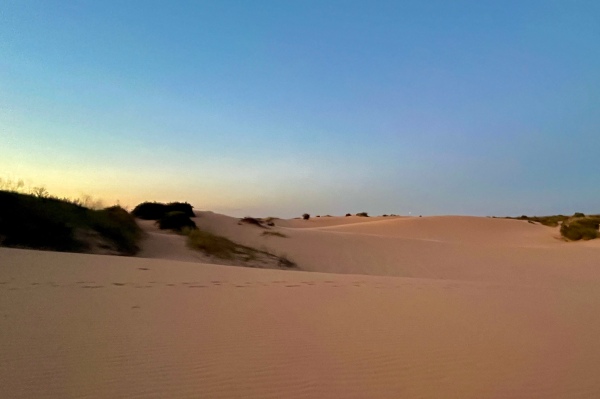

We quickly headed to the campground to set up camp while we still had (some) light, cook a couple of burgers, and be mesmerized by the gorgeous night sky. While we were setting up camp, I found an emesiine reduviid—a freakish-looking, rail-thin assassin bug that I don’t ever recall seeing before—on the campsite picnic table.

Later in the evening before turning in, I walked the roads—as is my custom—to see what beetles or other interesting critters I might come across. I only saw one tenebrionid, but I did encounter a fascinating case of cannibalism —a large Scolopendron polymorpha (desert centipede) that had captured and killed a smaller conspecific. The predator was a bit jittery and dragged its prey as it scurried away from my persistent attempts to look more closely at it but eventually settled down to allow me to see its venomous “claws” (modified first pair of legs) embedded within the body of its victim.


Day 3 — 12 Oct 2023
No lighting again last night, with cool temps and blustering winds that blasted all through the night. We slept comfortably though. We wanted to check the dunes before heading towards Black Mesa—me because I wanted to check the stands of Rhus aromatica (fragrant sumac), on which I had seen (but failed to collect) a single Lampetis drummondii, and Rich to look for fresh animal tracks in the sand. I did not see any Lampetis, but I did pick up a couple of Cicindela formosa and one C. scutellaris. I’d hoped to see more and get in situ photographs on the sand dunes, but it needed to warm up more before that would happen, and we were both itching to get started on our way to Black Mesa.

Near Kenton
Cimarron County, Oklahoma
The first jug trap (SRW) was not very full, and most of what was in there was moths. There were a few Euphoria inda, which had been dominate last time, but once again picking through the catch revealed no Cerambycidae. It was a completely different story, however, with the next two traps. In the SRW/EtOH trap I immediately noticed Tragidion coquus, and picking through the catch revealed at least five individuals. It was the same with the EtOH trap, which had at least four individuals. I did not notice any other Cerambycidae, but since T. coquus was a primary goal for the trapping effort—on top of the one I already got yesterday—I was thoroughly satisfied. The catch from all three traps was bagged for counting at a later date. The white bottle trap had no Acmaeodera sp., one Euphoria inda, and lots of orthopterans that I gave to Rich (plus 105 bees & 6 wasps for Mike). After finishing the traps, we checked several Gutierrezia sarothrae plants in bloom in the flats below the outcrop and, for a while, did not see anything until I found a single Acmaeodera rubronotata on the flowers of one of the plants. I believe this is a new state record (NSR) for Oklahoma—the second NSR I’ve gotten this year and the third in the past two years! We continued checking the G. sarothrae flowers as we walked back up the back road, but no more were seen. I even went back down and rechecked all the plants in the flats below and back up along the road, all to no avail. After I got back up to the vehicle, I returned to the SRW trap to retrieve a dead branch from the Pinus cembroides tree that the trap was hanging in which appeared to be infested with wood boring beetles and was brought back for rearing. There is a decent chance that whatever I rear out of the branches might be a new state record for Oklahoma, since this is the only place in the state where western pines are found—surely the insects associated with them will also be western.


Black Mesa State Park
Cimarron County, Oklahoma
The results for the first two jug trap (SRW & SRW/EtOH) were again similar to the previous site nearby, containing mostly moths, very few E. inda, and almost no Elateridae. However, once again I saw multiple individuals of T. coquus in both of them—what a fantastic result for the final trapping period of the study! Curiously, the third trap (EtOH) had few moths and no Cerambycidae (that I could see), and it was loaded with E. inda. The catch from all three traps was bagged for counting at a later date. The white bottle trap had no Acmaeodera sp. and 10 Meloidae (plus 40 bees for Mike). After we finished the jug traps, but before retrieving the Lindgren funnel trap, we hiked up the Overlook Trail to see if we could again find Lampetis (Spinthoptera) drummondii on the Rhus aromatica bushes (as I’d done last time). Along the way I found a yucca weevil on the trail. Amazingly, in almost exactly the same place as I’d found L. drummondii last time, we found them again—I let Rich have the first one after we both photographed it, and though it took a while we eventually found two more which I collected. With temps dropping and the sun sinking, we hustled back to the car to put away the traps we’d retrieved and then went up to North Canyon to retrieve the Lindgren funnel trap. I did not see any Cerambycidae in it—just moths and a few click beetles and E. inda. This was a disappointing result, considering the jug traps had done so well attracting T. coquus, but I bagged the catch and will go through it more carefully at a later date.


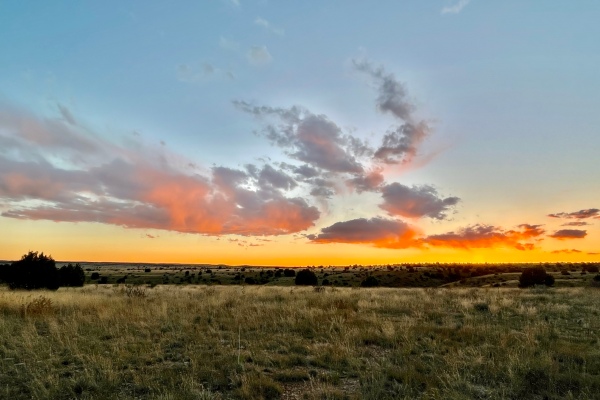
Day 4 — 13 Oct 2023
Jct Hwy 64 & N1250 Rd
Beaver County, Oklahoma
Last night was the coldest, windiest night of camping I’ve ever experienced! We were warm in our winter sleeping bags (although I did need to put my socks back on in the middle of the night), but the tent flapping awoke us frequently (and the one or two “necessary” exits from the tent in the middle of the night were not enjoyable!). When we did get up, the only thing we wanted to do was break camp and get in the car and out of the wind asap—breakfast and morning coffee would have to wait until we reached Boise City. All the traps had been checked, and while we had hoped to do a bit more collecting in the park before heading back to St. Louis, it wasn’t an option with temps in the mid-40s and biting north winds at 26 mph—nothing to do but start heading back. Along the way passing back through Beaver Co., we noticed lots of waterfowl in a large, shallow pond near the highway and pulled onto a nearby side road to get a better look at them. Even with binoculars we could only say for sure that they were ducks—they were too far away to identify beyond that. While we were there, I swept the extensive stand of sedges and rushes around the margin of the pond hoping to find Taphrocerus species—in this area I suspect T. chevrolati is the only species that would be encountered. None were found, even after quite a bit of sweeping—just a few flies and one 12-spotted cucumber beetle!

9.0 mi W Medicine Lodge on Hwy 160
Gypsym Hills Scenic Biway Info Kiosk
Barber County, Kansas
We had thought about stopping at Salt Plain State Park in Woods County, which our route back to St. Louis took us right by, but I had a better idea as we were approaching Alva, which is only 15–20 miles south of Hardtner, Kansas where “Beetle Bill” lives. I last saw Bill in 2004 when I visited him with Jeff Huether, and I thought it’d be nice to stop by and say hey before checking out a spot in the Gypsum Hills just north of town where Cicindela pulchra—one of North America’s most beautiful tiger beetles (the name literally translates to “beautiful tiger beetle”)—has been reported. Sadly, Bill was not in town that day, so we left our regards and continued on to the site.
Temps had warmed up to the mid-60s—warm enough, we thought, that insects should be active, but the winds had not abated in the least (to the point where I eventually decided to leave my cap in the car rather than chase after it repeatedly). Unfortunately, scanning the sparsely vegetated red clay soil at the site revealed no tiger beetles, so I began searching the blossoms of Gutierrezia sarothrae for Crossidius. Most of the scattered plants were on the tail end of their bloom, so there were not a lot of fresh flowers, but eventually I did find three individuals of C. pulchellus on the plants. As I searched the area for additional plants, I encountered the dried out carcass of a black vulture (Coragyps atratus). I don’t normally collect carrion-feeding beetles, but there are a few beetle groups of interest that I’ve encountered on carrion (e.g., checkered beetles of the genus Necrobia and dung beetles of the genus Onthophagus). I brought the carcass to the roadside and slapped it against the road to see what might be dislodged and found two species of Dermestidae. I know people who study these beetles, so I went ahead and collected a series of each—mostly because the host association was sorta cool! No other insects were seen during the visit, but I did encounter a recently-died Celtis reticulata sapling with fresh-looking, frass-packed galleries made by a jewel beetle (prob. Chrysobothris) and, thus, collected it for rearing. By the time I got the wood bundled up and placed in the car, we were both so done with the wind that we decided we’d had our fill of collecting and embarked on the final 7½ hours of driving back to St. Louis.

©️ Ted C. MacRae 2023









